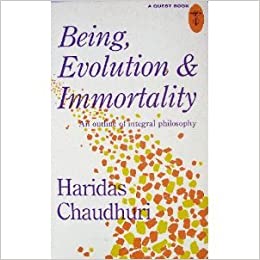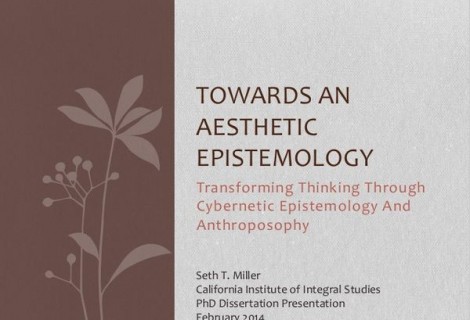Informal review of Being, Evolution, and Immortality: An Outline of Integral Philosophy, by Haridas Chaudhuri
My general impression of this work was that Chaudhuri was writing in a very philosophical style about a topic which is far more than philosophical. The extent to which he took pains to delineate some various philosophical perspectives so that he could present the viewpoint of the integral yoga surprised me; I’m not sure exactly what I was expecting, but I kept feeling like I was back in my undergraduate philosophy program, reading and comparing different works. The intellectualism that accompanies the philosophical world has some excellent and unfortunate consequences.
In the case of this book, I felt that on the one hand it provided a strong case for the philosophical underpinnings of the integral yoga, which can be useful for those who work through and towards the difficult topics he discusses in an intellectual way. By doing this, it can be possible for the intellect to contextualize the various meanings and approaches to things like the Divine, to the Non-dual, Being, the Absolute, and so forth, in such a way as to allow the rest of the human being to begin to find a way of moving with the material at a different level. I find that sometimes the intellect, lacking this context or ability to engage, results in either an over or under-attachment to the real content that is attempting to be addressed through philosophical language. In other words, the philosophical nature of the presentation calls forth the part of ourselves that is capable of dealing with the concepts in a direct, wakeful, conscious manner, which helps to mitigate either sympathetic or antipathetic reactions which may otherwise arise in its absence.
On the other hand, presenting material like this through a philosophical standpoint also lessens its potential impact by restricting itself to a style of address whose major target is the mental part of the human being. This is true even if the content of the words include ideas like love, goodness, and so forth; what comes across is often only the shell of an experience, rather than words designed for the immediate evocation of the experience. This is not so much a criticism as just how things like this often go, because we can only write and express so much through words without seeming almost schizophrenic. It seems that Sri Aurobindo, the major synthesizer of Integral Yoga (in concert with The Mother) worked on both sides of this issue, writing both intellectually and poetically as the need arose.
In reading Being I felt like I was assuming the posture of a bird in flight, soaring over a vast landscape and beneath an even vaster sky. I had the sense of swooping down occasionally towards the Earth, or of straining my wings to fly ever higher… but never did I feel either truly connected to either the Earth or the Heavens, but rather somehow suspended in between, almost as if in a strange form of limbo. I really wanted Chaudhuri’s discussion to find much more direct and explicit contact with experiences and realities of daily life. There were a few moments where he began to speak along such lines, but I felt that he continually abandoned routes that would have put him in real connection with the “world”. This is to say that his language had a tendency to be either vague, general, or simply descriptive of classes (or classes of classes) rather than elements of classes. Take almost any paragraph as an example; these are pulled from a random 5 second search:
(Tending towards Heaven:)
“Spiritual nondualism is inspired by the concept of the Absolute as supermind. The supermind is the sovereign dynamism of ultimate reality. it is the creative light of Being. It is the all-embracing consciousness, nondualistic in structure.” (p.60)
(Tending towards Earth:)
“Immortality is an attribute of enlightened consciousness. All men therefore have the potentiality of immortality by virtue of their consciousness. When the personality of an individual is harmonized and integrated, he attains enlightenment. He gains insight into his existential oneness with the all-encompassing Being. The veil of ignorance and separative consciousness is lifted from his eyes. Feelings of fear and insecurity, anxiety and personal unworthiness, are overcome. There is an enlargement of Being and joyful participation in the life of the Infinite. In one word, an individual experiences immortality here and now.” (p. 139)
In the first case we have what may be the normal limit of intellectual presentation: pointing at the moon. Were he to go further he would likely need to adopt a completely different style, and for the purpose of a survey work, this may be too much to ask. In the second case, although Chaudhuri is speaking about experiences that concern the transformation of the human being from existing in an ‘everyday’ state to one that exists in constant transformation and unfolding in the light of the Divine, he never gives much more detail than is apparent here. It’s hard to describe, because it is difficult to have clear and exact words about vagueness, but I get the feeling that almost the entire bottom foundation of the integral yoga is just missing from this book. How exactly does one practice integral yoga? What does the student encounter along the way? What exactly is happening to the student when his or her consciousness begins to transform, from the perspective of the multidimensionality of the human being, and how does this relate to advancement along the path? In other words, having read this book, I do not feel I have any clear answers to these questions.
Not knowing the context around the genesis of this book, it’s hard to know why he chose to approach it as he did, but he must have had a particular audience in mind. I keep having to remind myself that this was written around 1967; I wonder how he would have approached the same central task today? Nevertheless, as a philosophical outline it succeeds admirably, and this is ostensibly (given the title) its major purpose, so I would definitely call this book a succes.
A friend of mine pointed out that Chaudhuri puts forth a certain strength in the presentation of ideas about things which are more than ideas, given an impression that “this is how it is”, with no room for argument. I have a sense of how this happens (although whether this describes Chaudhuri’s case I have no idea, I’m only providing this perspective as my own). It’s not so much that the often absolutist tone of the presentation is meant to discount or override any alternate conception so much as it is an expression of the minds inability to fully conceptualize the extent of the topic that it is dealing with. This results in the mind reaching its limits; our words too, reach their limits. The experiences that lie beneath the philosophical considerations, and which give rise to them, although having a ‘word-like’ nature (logos), are not words in the normal sense. Thus all philosophical expression, when placed in service of what lies forever beyond it, can only be a sort of veil that covers what is otherwise unknown. But in the process, the veil assumes a certain shape, and certain tendencies for motion, as it falls lightly or heavily across the Mystery. Good philosophical discourse will be like a supple silk, capable of shifting delicately in response to its wearer (the Divine, or Being in Chaudhuri’s case) without either falling off, being too transparent and thus difficult to see, or too thick as to obscure what lies beneath — all while remaining self-connected, strong, and breathable.
But once a fabric is chosen, certain limits are necessarily adopted. In other words, getting into the frame of mind in which the human being is pouring attention into the intellectual contextualization of spiritual topics leads the mind into areas that it would not otherwise go; it is creating a space and exploring it at the same time, on the one hand coming up against its own limitations while discovering its own movements through a kind of self-necessity (in the clearest cases, this is expressed as “logic”). (Re: p.48, “Thought is not a mere process of mirroring. It is a creative function. In distinguishing definable features of reality, it also creates them in a profound sense.) Once certain choices have been made as regards to the style of approach, much of the rest ‘falls out’ in a way that is unavoidable; when standing within the perspective it seems directly and manifestly obvious that specific conceptions require a certain kind of expression. It just seems natural. So we end up with things like: “[Ideas] are not unalterably fixed truths.” (p. 49) and “The truth is that Being is multidimensional.” Each statement is formed and expressed from a perspective which gives rise to the necessity of each, while taken together they indicate that the chosen approach is self-limited (for those of you that are familiar with Goedel’s incompleteness theorem, this is an example of how it occurs linguistically).
This post is already too long, but this gives some general impressions. There are many details that I have comments or questions about, but I’ll leave these aside. I can add in closing that the philosopher in me found this work engaging, and it invites much in the way of philosophical discussion. For example, he has a tendency to simply state, almost by fiat, that such and such divisions or dualisms expressed elsewhere are overcome or united within integral nondualism… but the philosophical details he gives to back up his claims are far less detailed and clear than I would like them to be. I suspect this also may be due to the introductory nature of the work, and he has others which hopefully fill this gap.





